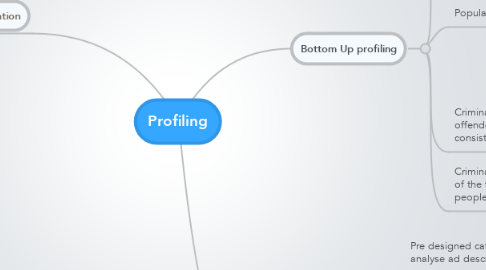
1. Evaluation
1.1. Deterministic
1.2. Ethnocenetric
1.3. Reductionist
1.4. Scientific Research
1.4.1. Method
1.4.1.1. Content analysis/ statistical process - sound scientific theory
1.4.2. Bias
1.4.2.1. Content analysis/ Statistical process not based on opinion
1.4.3. Reliabilty
1.4.3.1. Replicate - content analysis - cases
1.4.4. Sampling
1.4.4.1. Unrep/biased studies - not truly random ofetn opportunity based
1.4.5. Data
1.4.5.1. Quantitive/Qualitative
1.5. Situational/ Individual
1.5.1. Bottom up = situational
1.5.2. Top down = individual
1.6. Nature vs Nurture
1.6.1. Theories of profiling dont support either side
2. Top down profiling
2.1. Pre designed categories – analyse ad describe
2.1.1. E.g. star signs – basic info – predict future
2.1.2. Exists in offender profiling – creates typologies- clear/distinct categories
2.2. Exists in offender profiling – creates typologies- clear/distinct categories
2.2.1. Investigate clue for criminal type - Best fit
2.2.2. Criminal type identified - predict criminal’s next strike
2.3. FBI psych profiling centre - Behavioural Support Unit & National Centre for Analysis of Violent Crime
2.3.1. Data from FBI/Police – investigation/interviews with known offender
2.3.1.1. Determine major personality characteristic of offenders that separate them from non-offenders.
2.3.1.1.1. Info pooled – FBI typologies of serious offenders
2.3.2. Determine major personality characteristic of offenders that separate them from non-offenders.
2.3.2.1. Info pooled – FBI typologies of serious offenders
2.3.2.2. Ressler interviewed 36 murders – unstructured interviews – adhoc fashion – convicts gave permission
2.3.2.2.1. Organised and disorganised crime scene & offenders.
3. Bottom Up profiling
3.1. No assumptions
3.1.1. Gather all info - build logical decsion based on it
3.1.1.1. E.g. Tarot cards
3.2. Popular in Britain
3.2.1. Canter
3.2.1.1. Centre for Investigative Psych & Liverpool University
3.2.1.2. Orginally environmental psych - behaviour in buildings stay the same - in emergencies too
3.2.1.3. Avoid typologies & categorising offender arguing its importance to treat every case/offender - unique/ individual

